Ah-ah, ah!
Ah-ah, ah!
First, let me say that Thor: Ragnarok (2017; dir. Taika Waititi) is awesome. I’m delighted more each time I see it. Among Marvel films it’s no doubt top-5 for me. Yeah, I know that kind of statement is a fine way to pick a fight, but I really want to emphasize how I was blown away by the film from top to bottom.
This isn’t going to be a review of the film in any traditional sense, though. You’ve got one already.
I’m going to talk instead about the real Thor and the real Ragnarök. And to help me out, I’ve enlisted the help of my son, who is eleven years old and has read more than a few books on Norse mythology. (Like most of the huddled masses who watched Thor: Ragnarok, we’re gonna head straight from film to mythology and skip the comics in between.)
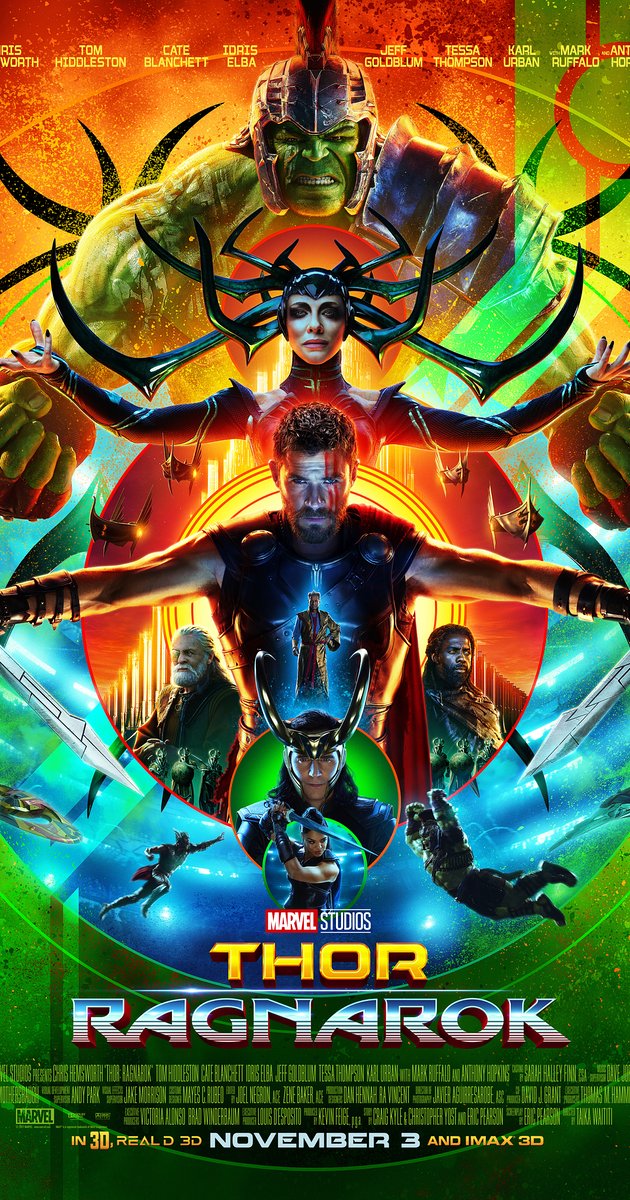
We come from the land of the ice and snow
From the midnight sun, where the hot springs flow
I’ve got a bit of an affinity for the Norse. During the course of my first Master’s degree — up in Michigan, which is a land of ice and snow indeed — I first delved into the sagas and songs, epics and tales of Norse literature. I fell for it hard, and I pretty much never came up. Now my son has caught the spirit, too. He cut his teeth on D’Aulaires’ Book of Norse Myths, moved into the Rick Riordan series built around it, and is stepping into the sagas (his favorite is the Saga of Harald Hardrada). Hell, the woman who recently became a part of our family (wife for me, mom for him) is, according to her DNA results, a Norse girl from Canada who went a-viking and amazingly ended up in South Carolina.
Speaking of Hell — I mean Hela, babe! — she’s played by Cate Blanchett in the film, who is squint-eyed cruel in a performance best described as “evil Galadriel.” She’s the eldest child of Odin (Anthony Hopkins), who locked her away after using her battle badassery to conquer the Nine Worlds for Asgard.
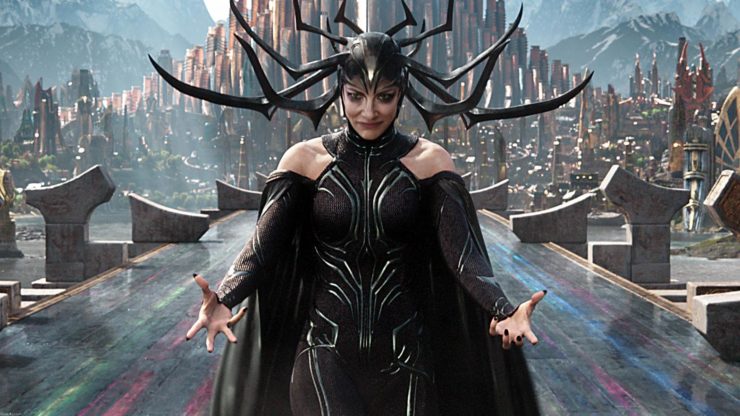
The hammer of the gods
We’ll drive our ships to new lands
To fight the horde, and sing and cry
Valhalla, I am coming!
(FILM SPOILER ALERTS!)
After Odin dies by releasing his spirit to the wind on a Norwegian coast, Hela is freed from her prison and comes to claim the throne of Asgard and bring it to the glory of conquering more worlds still. She destroys the beloved hammer of Thor (Chris Pine Pratt Hemsworth), forcing him into an excursion on the inter-dimensional trash planet of Sakaar, ruled by a figure called the Grandmaster (Jeff Goldblum). There he is helped on and off by his trickster brother Loki (Tom Swift Hiddleston), last-of-her-kind Valkyrie (Tessa Thompson), and the innnnncrediiiiiiible Hulk (Mark Ruffalo) to escape and make his way to Asgard.
Ah-ah, ah!
Ah-ah, ah!
We come from the land of the ice and snow
From the midnight sun where the hot springs flow
Fighting his big sis, Thor loses an eye to match the one-eyed Odin, then learns he doesn’t need his hammer to summon the lightning. To the tune of Led Zeppelin’s “Immigrant Song” — one of the finest matches of film to music ever — he becomes the lightning to fry Hela’s hordes of undead army dudes. Hulk beats the fur out of Hela’s zombie mega-wolf, while Valkyrie and Heimdall (Idris Elba) carve up more enemies. Thor then convinces Loki to summon the apocalyptic fire demon Surtur (Clancy Brown) to destroy the floating space-city of Asgard and fulfill the end-times prophecy of the final battle called Ragnarok. Hela wins Asgard but goes down with it.
How soft your fields so green
Can whisper tales of gore
Of how we calmed the tides of war
We are your overlords
On its surface this plot looks like stock blockbuster fare, though it turns out to be hilarious while having some rather deep resonance with some of the worst aspects of colonialism: conquest by blade and blood, followed by a forgetfulness. Also, there’s a final lesson in there about home not being a place but a feeling.
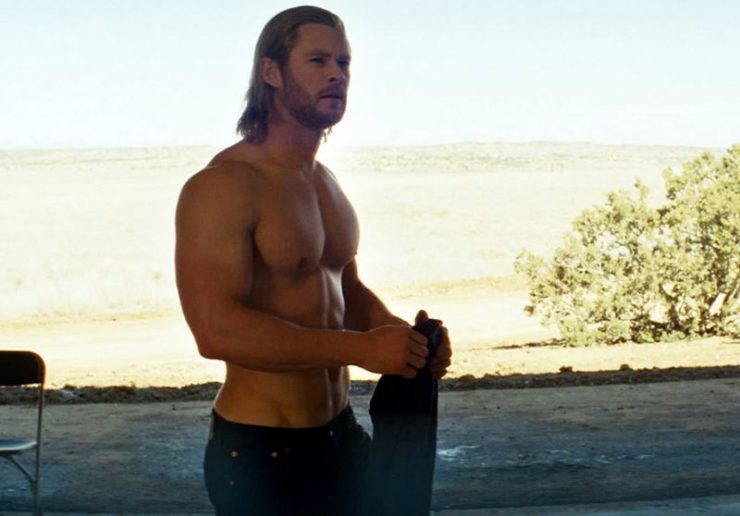
On we sweep with threshing oar
Our only goal will be the western shore
So now you’d better stop and rebuild all your ruins
For peace and trust can win the day despite of all your losing
But okay, how does this look against Norse Mythology and the real story of Ragnarök?
Well, Thor is definitely the Norse god of thunder. Check.
And as a professor of such things, I can assure you that he looks pretty much exactly like Hemsworth. Double pec check.
Thor also wields a mountain-leveling hammer, which is named Mjölnir. And Ragnarök is totally a thing in Norse mythology.
On we sweep with threshing oar
Our only goal will be the western shore
So far so good. But is anything wrong with all this? I asked my son to fact-check the film off the top of his head, and this is the 12-Item list he handed to me (in bold; with my comments between):

1. Hel is the daughter of Loki, not Odin.
True that. In Norse mythology, Loki has three children with a giantess named Angrboða who lives in the giant-realm of Jötunheimr (one of the Nine Worlds): Hel, the monstrous wolf Fenrir, and the world-serpent Jörmungandr. Hel is appointed to rule a hall of the dead in the frozen ice-realm of Niflheimr (another of the Nine Worlds). This place is called Hel, from which her name likely derives, and it’s the final resting place of the spirits of folks who didn’t do anything to distinguish themselves. A far better fate awaits those who die in battle, for instance, as most of them get to live in Odin’s hall in Valhalla, where they drink and slaughter each other each day only to awake the next day in perfect health. She plays exactly no part in bringing about Ragnarök. To the contrary, after it is done, she comes from Hel with Baldr and Hödr to help build the world anew.
Ooh-ooh, ooh-ooh, ooh-ooh
2. Loki is supposed to be helping the Giants not fighting them.
Yep. Loki joins up with the jötnar for Ragnarök. What a punk.
Ooh-ooh, ooh-ooh, ooh-ooh
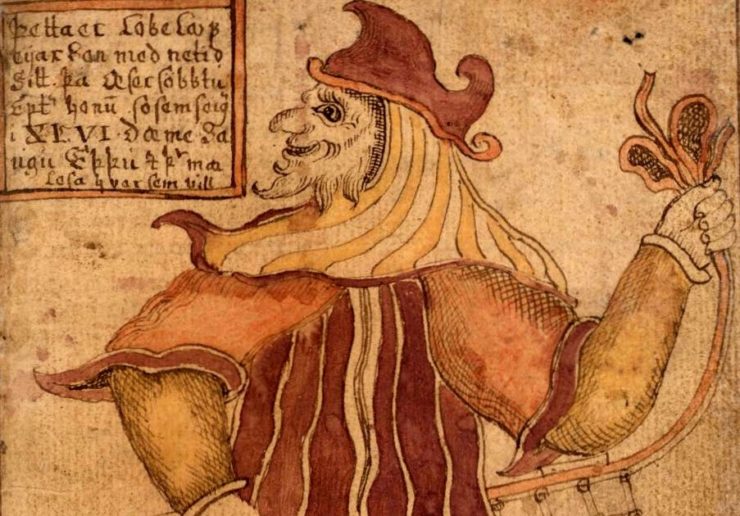
3. At Ragnarok Odin is supposed to kill and be killed by Fenris wolf.
Pretty much. Odin bravely takes on Fenrir, whose open jaws reach from the sky to the sea, but the wolf swallows him whole. Odin’s son Víðarr then grabs the wolf’s jaws and rips it in two, killing it.
Ooh-ooh, ooh-ooh, ooh-ooh
4. All the Nine Worlds are supposed to burn, not just Asgard.
What happens to all Nine Worlds isn’t totally clear, but Earth, in particular, is very much supposed to fry. Here, our Middle-earth makes no appearance.
Ooh-ooh, ooh-ooh, ooh-ooh
5. Thor can not die from the evil goddess because he’s destined to die from the world serpent.
Yep. At Ragnarök Thor wrestles with Jörmungandr and kills it. But in so doing he is poisoned (this has interesting echoes in Beowulf’s end, FYI). He staggers nine steps before he collapses and dies.
Ooh-ooh, ooh-ooh, ooh-ooh
6. At Ragnarok more gods should be there, not just Heimdall, Thor, and Loki.
Absolutely! A whole host of gods should be there — along with armies of frost giants, armies of fire giants, an army of Odin’s chosen badass Vikings called the einherjar, a massive dreadknought ship made of dead men’s fingernails, and much else besides. Anyone who is anyone is at Ragnarök, including one of the biggest names in the Norse pantheon…
Ooh-ooh, ooh-ooh, ooh-ooh
7. Frey should be at the battle because he is destined to be killed by Surt.
Freyr is a fertility deity who rivaled Orin and Thor in popularity back in the day. Often depicted as a phallus, Freyr will be killed by Surtr because (oh the irony!) he doesn’t have his, um, special sword with him.
Ooh-ooh, ooh-ooh, ooh-ooh
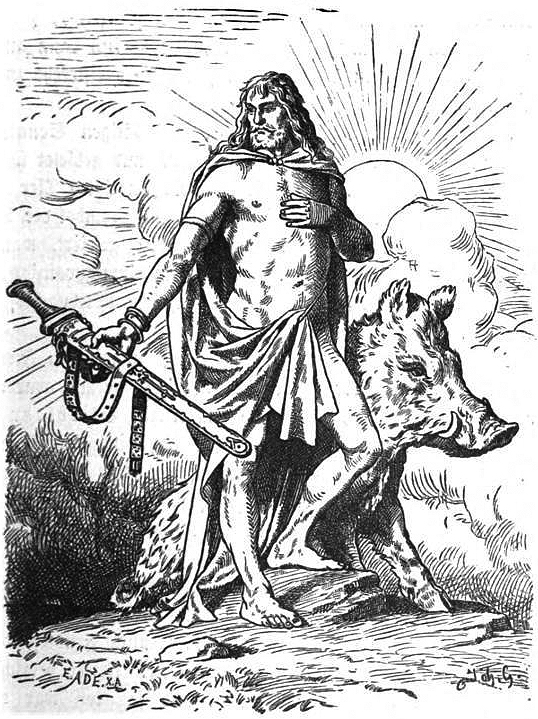
8. For Marvel fans Sakaar is Planet Hulk not a garbage planet.
I said we were gonna keep the comics out of this, but the lad apparently couldn’t resist himself here. Kids, eh?
Ooh-ooh, ooh-ooh, ooh-ooh
9. Loki is destined to be killed by Heimdall yet they are fighting together.
Exactly so. Heimdallr is the gold-toothed uber-watchman of Asgard, and he and Loki slay each other at Ragnarök.
Ooh-ooh, ooh-ooh, ooh-ooh
10. A valkyrie is sworn to Odin’s service so Valkyrie can’t just resign from her position.
Damn straight, lad. Once a valkyrja, always a valkyrja.
Ooh-ooh, ooh-ooh, ooh-ooh
11. How can the goddess of death die, because death can not be killed.
Well, Hel isn’t at all the goddess of death in Norse mythology the way they depict her in the film. But also, damn, that’s a terrific philosophical point.
Ooh-ooh, ooh-ooh, ooh-ooh
12. Even if it was possible for her to die then that would make everybody immortal.
A child’s logic for the win, and a downer for any sense of danger for the Marvel Cinematic Universe moving forward.
Ooh-ooh, ooh-ooh, ooh-ooh
So yeah, there’s a lot in this movie that doesn’t mesh at all with the real Norse mythology. But it’s still fun as Hel(l).
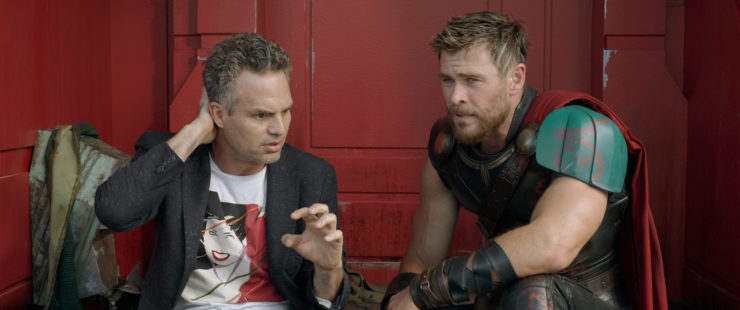
And, truthfully, it’s hard not to be delighted with how much they did manage to sneak in, including Bruce Banner wearing Tony Stark’s t-shirt featuring Duran Duran’s hit album Rio … whose second single was “Hungry Like the Wolf.”
That’s seriously clever foreshadowing, filmmakers.
Now, if y’all could somehow incorporate having part of Thanos’ ship in Infinity War be made with the fingernails of dead men, that’d be super.
Mike’s Medieval Mythological Ratings
Authenticity: 2 out of 3 Loki’s hideous offspring
Just Plain Fun: 11 out of 10 piles of rocks waving at you
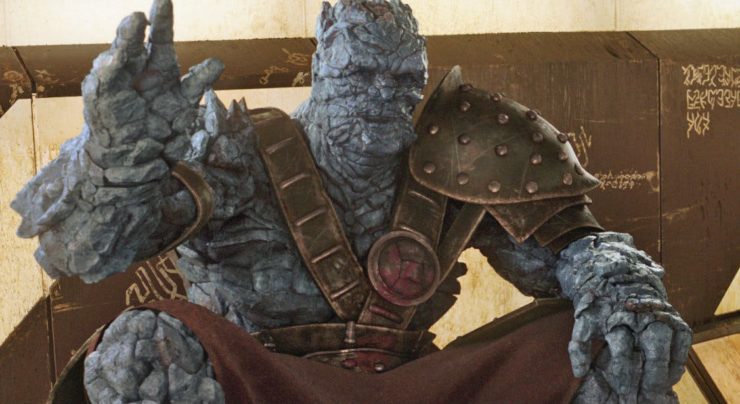
(Immigrant Song lyrics © Warner/Chappell Music, Inc.)
 Michael Livingston is a Professor of Medieval Culture at The Citadel who has written extensively both on medieval history and on modern medievalism. His historical fantasy trilogy set in Ancient Rome, The Shards of Heaven, The Gates of Hell, and the newly released The Realms of God, is available from Tor Books.
Michael Livingston is a Professor of Medieval Culture at The Citadel who has written extensively both on medieval history and on modern medievalism. His historical fantasy trilogy set in Ancient Rome, The Shards of Heaven, The Gates of Hell, and the newly released The Realms of God, is available from Tor Books.










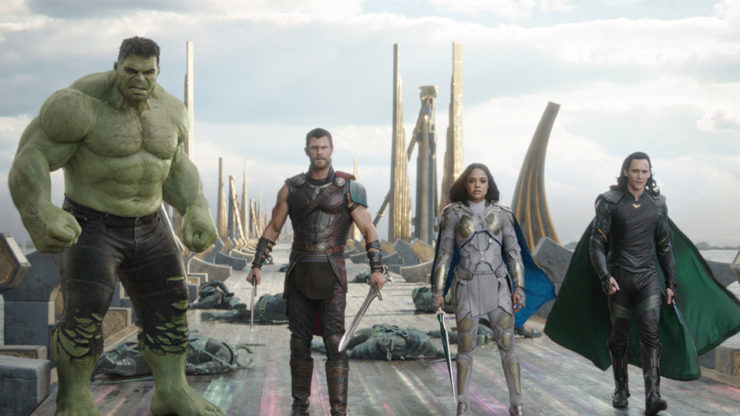
Hel is my favorite Norse Goddess. Okay the half dead thing is icky but you’d get used to it. She’s got a whole Dimension of her own and is a major force to deal with. Like Hades she’s sometimes cast as a villain but in fact she’s just a woman doing her job, collecting and protecting the non-heroic dead. If she’s pissed over the way the Aesir have treated her father and brother who can blame her? She hangs on to Baldur because, sorry guys, those are the rules. She even tries to bend them a little, it’s not her fault the Aesir can’t meet her condition it’s Loki’s.
Needless to say I was less than thrilled by the Marvel take on my goddess. But I don’t expect accuracy from them.
Hel is only the “Death Goddess” because Odin makes her so.
I expect it comes as no surprise to anyone reading this board that the Marvel Comics interpretation of the Norse myths diverge sharply from the sagas told around smoky firepits under snow-covered thatched roofs in 8th-cen Scandinavia — but fresh interpretations weren’t invented by the 20th-cen American mass entertainment industry. “Folklore wants to be free,” to adapt a phrase, and making kids aware of the distinction is important chiefly to prevent them from cramming for literature tests by watching Disney movies.
“A little knowledge is a dangerous thing,” and if you read only one pop-factual account about Norse myths (or anybody’s myths) you might get the notion that there’s a single, authoritative version — but there probably wasn’t. Given what little we know, and human nature, it’s likely that (during the centuries when these personages had cultural currency) many other stories were told, stories that haven’t survived. Heck, even the concept of “authoritative” is inapplicable if the characters are shared by different city-states and wandering bards, all spinning tales independently. (Now, the Egyptian Book of the Dead — that one, you’d want to be sure that the scribe you hired made a reliable copy for your tomb, because if you flub those magic formulas, your afterlife is doomed.)
You have to be a serious historian to be aware of the primary sources, reconstruction from fragments, and conflicting accounts — which lets you suss the boundaries of what we don’t know. All that labored investigation, all the caveats, get abstracted away. (I’ve been paying attention to this process lately — re-reading back issues of Science News from the ’90s to see the scientific sausage getting made; answering questions on Quora and pausing to ask “how do we really know this?”; checking the attributions in Egyptology books — “is this image of a tomb an accurate painted copy, by which early historian; the style applied to which dynasty?”)
I only just got something. On the poster, they’re all in concentric circles, and have their arms out, almost like the branches of a tree. If you look at it from that point, they’re all in the shape of Yggdrasil.
Love the movie. Love the article.
Hahaa. (Chris
PinePrattHemsworth). That leaves only Evans, but he was probably busy somewhere between Wakanda and everywhere else. I have long since noticed that Hollywood is blessed with Chrises. Too bad Pine is already used in DC and thus probably unavailable for Marvel CU.I read Gaiman’s take on the Norse Mythology and although I knew the gist of who’s who and what’s going on, it was still very interesting and informative (e.g., I discovered Caitlin Kiernan has very successfully used names from the myths (like Embla, Surtr, and a bit modified Ashkr), that I so far thought nothing of, as characters’ names in her Moorehawke trilogy). It was also very interesting to see how much of the “real deal” was incorporated into the movie when I first saw it in the end of October. And I must admit, what concerns Loki, he was a real assb*tt in the mythical Ragnarök, so I much preferred this version, because how can you not love Tom Hiddleston(‘s Loki)? Like, seriously? How would that even be possible?
@2, Loki brings his three odd ball kids to live with him in Asgard but they totally don’t fit it; A giant wolf and a serpent both of whom keep growing, and a half dead girl. Fenrir is treated very badly. Jormungandur I’m not so sure about, being thrown in the ocean sounds rough but on the other hand she gets to really stretch out down on the Ocean floor. Hel get’s the best deal being given her own kingdom, okay it’s dark and peopled by the Dead but she grew up in the Ironwood she’s probably right at home. And nobody makes comments about her appearance.
I feel this old and fun article is relevant to the discussion!
https://www.tor.com/2014/02/22/happy-ragnarok-time-to-choose-a-side/
Great article! You and your son should team up more often. If he keeps this up, you are going to have to give him co-author credit up in the byline.
Here’s where I point out that Thor looks smashing in a wedding dress.
I’d probably say 3/3 for Loki’s children – I think the serpent-thing that Thor kills at the beginning (in Surtr’s realm) is probably supposed to be Jormungandr.
“Real Ragnarok”
Really?
Like the for real Ragnarok?
I see that Samuel got his mention in the byline! Well done!
Nice team-up between you and your son, Michael. My own 13 year old co-hosts my podcast with me, and has been doing so for a few years, having been part of the staff since he was like 7, and hanging around the microphone since he was born. He even co-hosted a live radio show with me for a while.
Here’s to more geeky father and son team-ups.
As a kid in the 70s I’ve read The Mighty Thor
& Odin was preoccupied by trying to prevent Ragnarok or at least try to save the Asgardians
this run of Thor (1966) #272-278 gobsmacked me
Roy Thomas loved Norse mythology later on would work in the Ring Cycle
https://www.amazon.com/Thor-Ragnarok-Roy-Thomas/dp/0785149783
What, no mention of Sleipnir, Odin’s 8 legged horse, in the list of Loki’s kids? Loki, in the guise of a mare, spent a very lovely evening with a stallion and gave birth to the horse.
Thanks for the article, it really helped my School Project.